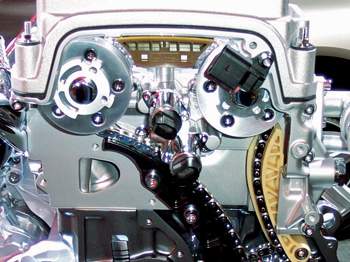Tech Tip: Kia Constant Variable Valve Timing (CVVT) Oil Control Valve Inspection
This bulletin provides information related to the Oil Control Valve (OCV) used in Constant Variable Valve Timing (CVVT) systems. If, at any time, the OCV is suspected as a cause of rough idling, poor acceleration, camshaft timing misalignment-related trouble codes, misfire-related trouble codes, etc., on a Kia vehicle equipped with a CVVT system, be sure to perform the OCV inspection procedure below before replacement.
The Ins and Outs of Variable Valve Timing (VVT) Systems and Their Role in Vehicle Emissions
By the early 1990s, almost all import automotive manufacturers had a successful variable valve timing (VVT) system in production. These systems offered higher performance from smaller displacement engines at higher rpm. Do you know that VVT is playing a direct role in vehicle emissions and the way gases are burned in the combustion chamber?

Book Report: Tips for Ford Power Stroke Service and Rebuilds
The book covers the vast majority of Power Stroke diesel engines on the road, and gives you the full story on their design.
GM Tech Tip: Crankshaft Rear Main Oil Seal Leaks in Some 60-degree V6 GM Engines
Some GM owners may complain about external oil leaks from these engines. Before replacing the new design rear main oil seal, be sure the PCV system is operating correctly.
Service Solutions: The ‘CKP’ Script
The signal of the position or rotation speed of the crankshaft position sensor (CKP) contains a lot of information about the engine. When the engine is operating, the engine cylinders push on the crankshaft journal. This is why the crankshaft briefly accelerates after top dead center (TDC) on the expansion (or combustion) stroke. If the fuel did not ignite in the cylinder there would no acceleration.
Transmission Update: Speed Sensor Diagnostics
Weird and unusual problems are my bread and butter diagnostics. By the time these odd problems get to me the owner of the vehicle has more than likely reached their threshold of poor diagnostics skills and bad results. Their opinion of every technician out there comes down to the same inevitable answer: “We’re all the same.” I doubt that very seriously. It’s almost laughable when you start quizzing them on where they had their car prior to bringing it in.
Tech Tip: Toyota Matrix MIL ON/DTC’s P0011, P0012 or P0016 Set
Under certain conditions, customers may experience an MIL On condition with DTC P0011, P0012 or P0016 stored in the Engine Control Module/ECM.
Tech Spec: Nailing Down the Misunderstood Buick Nailhead
Like the Small Block Chevy, the Rocket 88 Olds, the Ford Flathead and the Chrysler Hemi, the Buick Nailhead engine is one of those that has the immortal smell of history all over it. Yet, unlike its more familiar brothers, cousins and even competitors, the Nailhead has an aura of mystery about it as well.
Nissan Driveability Case Study and More Covered in Free New Wells ‘Counterpoint’ Newsletter
The technical services team at Wells Vehicle Electronics offers a detailed diagnostic case study covering Nissan variable valve timing (N-VCT) and an in-depth look at crankshaft position sensors in the latest issue of Wells’ popular CounterPoint newsletter.
Diagostic Dilemmas: Lost in ‘The Diagnostic Woods’
This real-world case study of a 2002 Chevy S-10 pickup, a 1995 Buick and a 1995 Lincoln Town Car illustrates why “chasing” trouble codes can get you lost in the Diagnostic Woods.
Tech Tip: Cam and Crank Sensor Diagnosis
Today’s cars have several different methods of producing spark and setting fuel injector pulses. All of the sensors create a nominal voltage by way of what is referred to as a “Hall effect,” either from an external magnet mounted on the cam gear or body of the distributor housing, or it has its own small magnet inside itself and the Hall effect is created by passing the sensor over or near a piece of slotted metal.
Crankshaft and Camshaft Position Sensor Diagnosis
Nothing is more frustrating than diagnosing an intermittent cranking, no-start complaint with no diagnostic trouble codes (DTCs) and no apparent failure pattern. Much of the time, the cranking, no-start complaint lies with a failing crankshaft or camshaft position sensor. Many of these failures can be heat-related and might require several warm-up cycles to duplicate.
